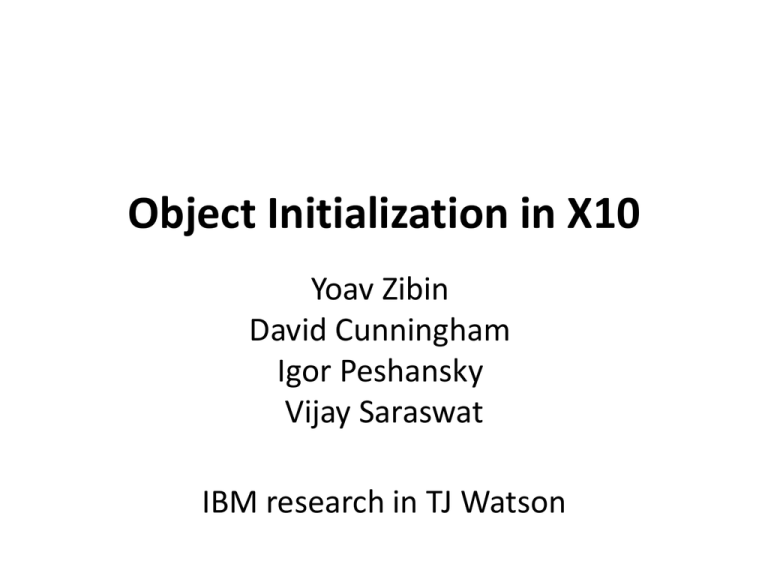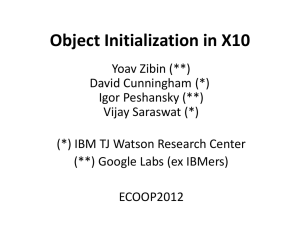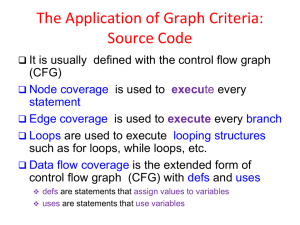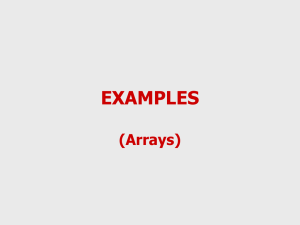Object Initialization in X10
advertisement

Object Initialization in X10
Yoav Zibin
David Cunningham
Igor Peshansky
Vijay Saraswat
IBM research in TJ Watson
Initialization Can be Tricky
• Reason 1: dynamic dispatching
abstract class A {
A() {
System.out.println(“me=“+this.description());
}
abstract String description();
}
class B extends A {
int b = 2;
public String description() {
return “b=“+b;
}
}
Initialization Can be Tricky
• Reason 2: leaking a raw/uninitialized object
class A {
public static HashSet set = new HashSet();
A() {
set.add(this);
}
}
class B extends A {
final int b = 2;
}
Initialization Can be Tricky
• Reason 3: concurrent and distributed code
class Fib {
val fib2:Int; // fib(n-2)
val fib1:Int; // fib(n-1)
val fib:Int; // fib(n)
def this(n:Int) {
finish {
async {
val p = here.next();
fib2 = at(p) n <=1? 0 : new Fib(n -2).fib;
}
fib1 = n <=0? 0 : n<=1? 1 : new Fib(n -1).fib;
}
fib = fib2+fib1;
}
}
Desired Initialization Properties
• Cannot read uninitialized fields
– C++: uninitialized fields have unspecified value
– Java: fields are zero initialized
• Final fields
– Written exactly once
– Single value for final fields
•
•
•
•
Immutable objects are thread-safe
Simple (initialization order is clear)
Flexible (ability to express common idioms)
Type safe
X10 Initialization Rules
• Hard-hat design
– Strict:
E.g., mostly no dynamic dispatching , no leaking
this.
– Pros: has the desired properties (simple, type safe,
etc)
– Cons: Less flexible, e.g., cannot express cyclic
immutable data-structures
Rules Overview
• Demonstrate the rules by examples
• Initialization is a cross-cutting concern
– Dynamic dispatching and leaking this
– Default/zero value
– Properties
– Generics
– Concurrent and distributed programming
– More in the paper:
• Inner classes, exceptions, closures, structs, serialization,
cloning, and more…
this escaping
• this is raw in non-escaping methods
(constructors and methods called from them)
• A raw this cannot escape or be aliased.
class A {
val f:Int;
def this() {
m1();
f = m3();
LeakIt.leak(this); // ERR
}
private def m1() { m2(); }
final def m2() {}
@NoThisAccess def m3() = 1;
}
Has-zero
• Definition of has-zero
– A type has-zero if it contains the zero value (which
is either null, false, 0)
(A struct and type parameter may also has-zero)
• A var field that lacks a field initializer and
whose type has-zero, is implicitly added a zero
initializer.
class A {
val i0:Int; //ERR
var i1:Int;
var i2:Int{self!=0}; //ERR
}
Properties
• Properties are final fields that are initialized
first using property(...);
class A(a:Int) {}
class B(b:Int) {b==a} extends A {
val f1 = a+b;
def this(x:Int) {
super(x);
super init
val i1 = super.a;
Field initializers are
Properties init
val i2 = this.f1; //ERR
executed after
property(x);
property(…)
Field init
val i3 = this.f1;
}
}
Generics
• haszero type predicate
class B[T] {T haszero } {
var f1:T;
val f2 = Zero.get[T]();
}
class Usage {
var b1:B[Int];
var b2:B[Int{self!=0}]; //ERR
}
class Array[T] {
def this(size:Int) {T haszero} {…}
def this(defaultElement:T,size:Int) {…}
}
Concurrent programming
• finish and async
• A constructor must finish assigning to all fields
class A {
val f1:Int;
val f2:Int;
def this() {
async f1 = 2; // ERR
finish {
async f2 = 3;
}
}
}
Distributed programming
• at shifts execution to another place
• A raw this cannot be captured by an at.
class A {
val f:Int;
def this() {
at (here.next())
this.f = 1; //ERR: this escaped
}
}
Definite assignment
class A {
var i:Int{self!=0} , j:Int{self!=0};
def this() {
finish {
asyncWriteI(); // asyncAssigned={i}
writeJ(); // ERR
} // assigned={i}
writeJ();// assigned={i,j}
}
private def asyncWriteI () {// asyncAssigned={i}
async i=1;
}
private def writeJ() {// reads={i} assigned={j}
if (i==1) writeJ(); else this.j = 1;
}
}
Previous work
•
•
•
•
•
Java
C++
Non-null types
Masked types (Qi and Meyers)
Detector uninitialized fields
Conclusion
• Java and C++ initialization is error-prone
• X10 initialization design
– Strict: protects from errors
– Simple
– Flexible (but cannot express cyclic immutability)
– Type safe
– Final fields has a single value
• See paper for alternative designs (e.g., proto)
• Questions?











